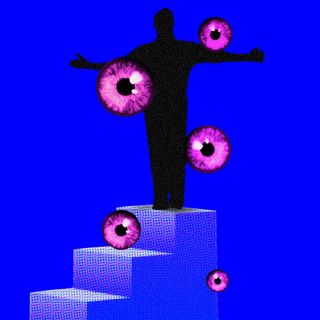
How Autism Interventions Are Starting to Move Away From ‘Fixing’ Autistic People
The neurodiversity movement is gradually changing the focus of autism-related healthcare from “cure” to “care.”

Society’s obsession with “normal” — roughly translating into “able-bodied and neurotypical” — can be so overwhelming that autistic people are often forced to suppress their very neurotype, their true selves. In a bid to fit in by putting on their “best normal” — so they can avoid being pitied, patronized, babied, ostracized, hated on, harassed, or bullied for being different — autistic people resort to masking, often despite being unaware of their autism, and without having the faintest idea of what “masking” entails.
In addition to both generalized and social anxiety, masking can lead to depression, self-harm, and suicidal tendencies, especially due to “thwarted belonging,” which is defined as “a psychologically painful mental state that results when the fundamental need for connectedness” isn’t met. Consequently, many late-diagnosed autistic individuals wish they’d learned about their autism sooner; they wonder if it would’ve prevented them from descending into self-hate and, instead, allowed them to structure their lives around their disability much sooner. However, one cannot deny the likelihood of harmful interventions following an early diagnosis — especially since autism-related healthcare is only now beginning to move away from its erstwhile goal of “fixing” autistic people.
For decades, applied behavioral analysis (ABA) — a scientific discipline that espouses a narrow definition of normal and trains people to adhere to it — was believed to be the “longest-standing and best-established form of therapy for children with autism.” Now, it’s been drawing censure since the neurodiversity movement started gathering momentum, and autistic individuals subjected to ABA as kids began speaking up about the cruelty it meted out to them. ABA, too, in a way, forces autistic individuals into masking — by training them to do so through a framework of punishments. The forced conformity is as damaging to an autistic individual’s mental health, if not more, and puts them at a greater risk of dying by suicide.
“[Autism self-advocates] contend that ABA is based on a cruel premise — of trying to make people with autism ‘normal’… What they advocate for, instead, is acceptance of neurodiversity — the idea that people with autism or, say, attention deficit hyperactivity disorder or Tourette syndrome, should be respected as naturally different rather than abnormal and needing to be fixed,” notes a report on the controversy surrounding ABA.
Related on The Swaddle:
Why We Expect People With Invisible Disabilities To Learn To Act ‘Normal’
Finally, it appears the voices of actually autistic individuals are being heard. “We’ve moved away from thinking of autism as a condition that needs to be eliminated or fixed to thinking about autism as part of the neurodiversity that exists across humankind,” Geraldine Dawson, director of the Duke Center for Autism and Brain Development in Durham, North Carolina, told Scientific American.
Dawson was recently involved in co-authoring a paper, published in JAMA Pediatrics, on the ongoing reassessment of treatments and therapy for autistic individuals. The approach doesn’t suggest that surviving as an autistic individual in a world that’s largely uninformed about neurodivergence needs no guidance. It can be argued that the quality of life among autistic adults is shaped by two things: the experience of living with autism in itself, and the manner in which autism is perceived by people around them. In a society designed for neurotypical brains, autistic people often end up feeling helpless and lonely — impacting their mental health. In addition, the ableism an autistic person is often forced to encounter on a daily basis worsens matters — overall, bringing down their quality of life. As a result, seeking accommodations and interventions is frequently a part of autistic existence.
Crediting the neurodiversity movement for ushering changes in autism healthcare, Dawson explains how it’s possible to offer help to autistic individuals in navigating a world not designed for them without coercing them into pretending to be someone they aren’t.
That doesn’t, of course, mean allowing harmful behaviors, like head-banging, to go on — instead, it advocates for teaching autistic individuals healthier ways to express themselves so that the need for harmful behaviors doesn’t arise. Teaching them strategies to cope with emotional dysregulation, or enabling them to stim in ways that don’t put them at risk of injury — irrespective of whether or not their strategies and behaviors are socially acceptable — can be a way forward. “[I]f someone rocks back and forth because it makes them feel calmer, I feel that our society should be accepting of different ways of being in the world,” says Dawson.
Related on The Swaddle:
Not Every Autistic Person is a ‘Savant.’ But the Stereotype Has Significant Mental Health Costs.
Citing the example of an autistic teenager who no longer wanted to work on developing better eye contact — a “skill” autistic individuals are often forced to learn in ABA — Dawson notes, “That should be okay. If you think about the people you know, there are those who make a lot of eye contact and others who make less.” The new approach to healthcare surrounding autism, then, focuses on what the autistic individual would prefer to work on, rather than imposing an ableist idea of “normal” upon them, and then, forcing them to conform.
Yet another recent study — investigating the impact of cannabis on autistic individuals — explored improving the quality of an autistic person’s life without attempting to modify their autistic traits. “Adults with [autism spectrum disorder (ASD)] face an array of challenging symptoms associated with the condition, which can have a devastating impact on their quality of life. The goal of treatment here is not to modify the core traits of autism. These can be valuable and invariably form a core part of a person’s identity,” James Rucker, a consultant psychiatrist who had co-authored the study, noted. Rucker’s statement, too, speaks to the evolution of autism healthcare, brought upon by the neurodiversity movement.
While the changes are certainly welcome, autistic individuals do remain concerned due to the ableist biases that might be deeply entrenched within many medical professionals and inform the way they approach autism. “When disability is defined by behavior, researchers and clinicians struggle to identify appropriate measures to assess clinical progress. Some choose the reduction or elimination of diagnostic traits, implicitly defining typical appearance as the goal of service provision,” Ari Ne’eman, an autistic individual and a disability rights activist, had written in a paper. “Such an approach often interferes with more meaningful, person-centered goals; causes harm to people with disabilities.”
Ne’eman’s worries aren’t unfounded. Dawson’s words, though, do provide hope — if not of rapid change, then of slow evolution.
Devrupa Rakshit is an Associate Editor at The Swaddle. She is a lawyer by education, a poet by accident, a painter by shaukh, and autistic by birth. You can find her on Instagram @devruparakshit.
Related


Loud Music, Venues Could Be Putting Over 1 Billion Young People at Risk of Hearing Loss
